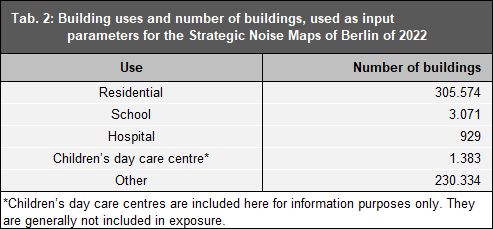The building height was calculated from the number of storeys applying the formula building height = 3.2 m + number of storeys x 2.8 m. It was derived from the EBA building data set that each dwelling has an average volume of 414.4 m³. By further assigning 2.1 inhabitants to each dwelling, the number of inhabitants was determined for each residential building (classification based on the ALKIS object key) from the building volume (inhabitants = 2.1 x volume / 414.1 m³). Mixed residential buildings with commercial use were only assigned half the volume (Wölfel 2023).
Building facades are included in the calculations as reflective with a “smooth/ reverberant” surface according to Table 9 of the LAI instructions (LAI 2022).
Dwellings
The number of affected dwellings is derived from the known number of affected inhabitants. A flat ratio of 2.1 inhabitants per dwelling is applied, which was also suggested in the LAI instructions (LAI 2022).
Road location and traffic
The Noise Mapping 2022 is based on the city road and motorway network from the environmental network (data basis: _VMZ-Detailnetz_, as of February 2022) of the Senate Department for the Environment, Urban Mobility, Consumer Protection and Climate Action as well as traffic volumes from the 2019 census including updates of permissible maximum speeds and road-related parameters from 2021.
We would like to refer to Chapter 4.7 of the project report (Wölfel 2023) once again, which explains the complexity of factoring in various influences in the calculation model in regard to roads (traffic volumes, standard cross-sections, road surface types, etc.).
A total of 1,770 km of road network were included in the calculation. Other relevant primary network roads in the Brandenburg region, located no more than 2 km from the Berlin border, were also included if they exceeded the defined immission level results.
Tram and Underground (Above-Ground Sections) Location and Traffic
_Tram_
A total of 205.9 km of the tram network was modelled:
- correction of the position based on the network geometry planning documents of the tram tracks provided by the BVG, with reference to orthophotos;
- counting sheets of all BVG tram journeys in regular service and trips to the depots based on the schedule of Schöneicher-Rüdersdorfer Straßenbahn GmbH on December 17, 18 and 19, 2021; traffic averages for the year 2021;
- adaptation of road types according to BVG specifications;
- correction values for curve squeal noise by adjusting the calculation parameters to the radius of the curves; and
- adoption of current BVG information on maximum permissible speeds.
_Underground (Above-Ground Sections)_
Both the location of the underground network and the route parameters are based on the network of the Level 3 (2017) mapping and are used here with the following modifications:
- the interval master timetable of the BVG (valid from December 12, 2021) of the line network and the table of trips to the depots are used to update the traffic data;
- the calculation parameters are adapted to the curve radii and lubrication systems to calculate curve squeal noise.
A total of 28.6 km of the underground network was modelled.
IED Plants
The Berlin noise mapping for IED plants that impact environmental noise includes 18 power plant sites.
The sites were taken from the Level 3 (2017) mapping and transferred to that of 2022 without change.
The Lichterfelde cogeneration plant was the only site for which the areas were adapted.

